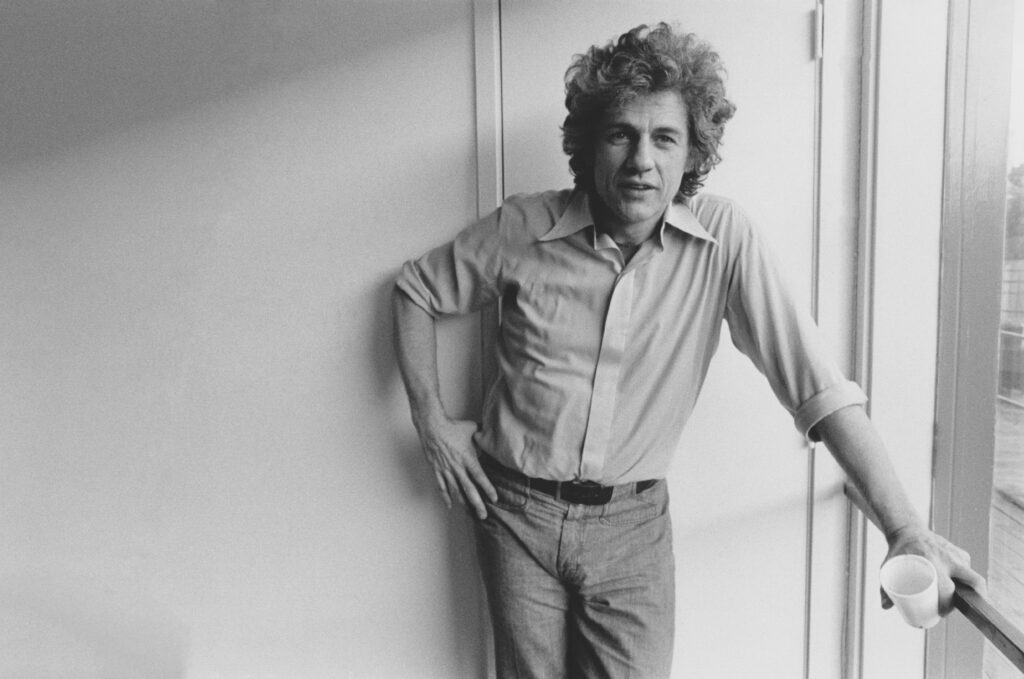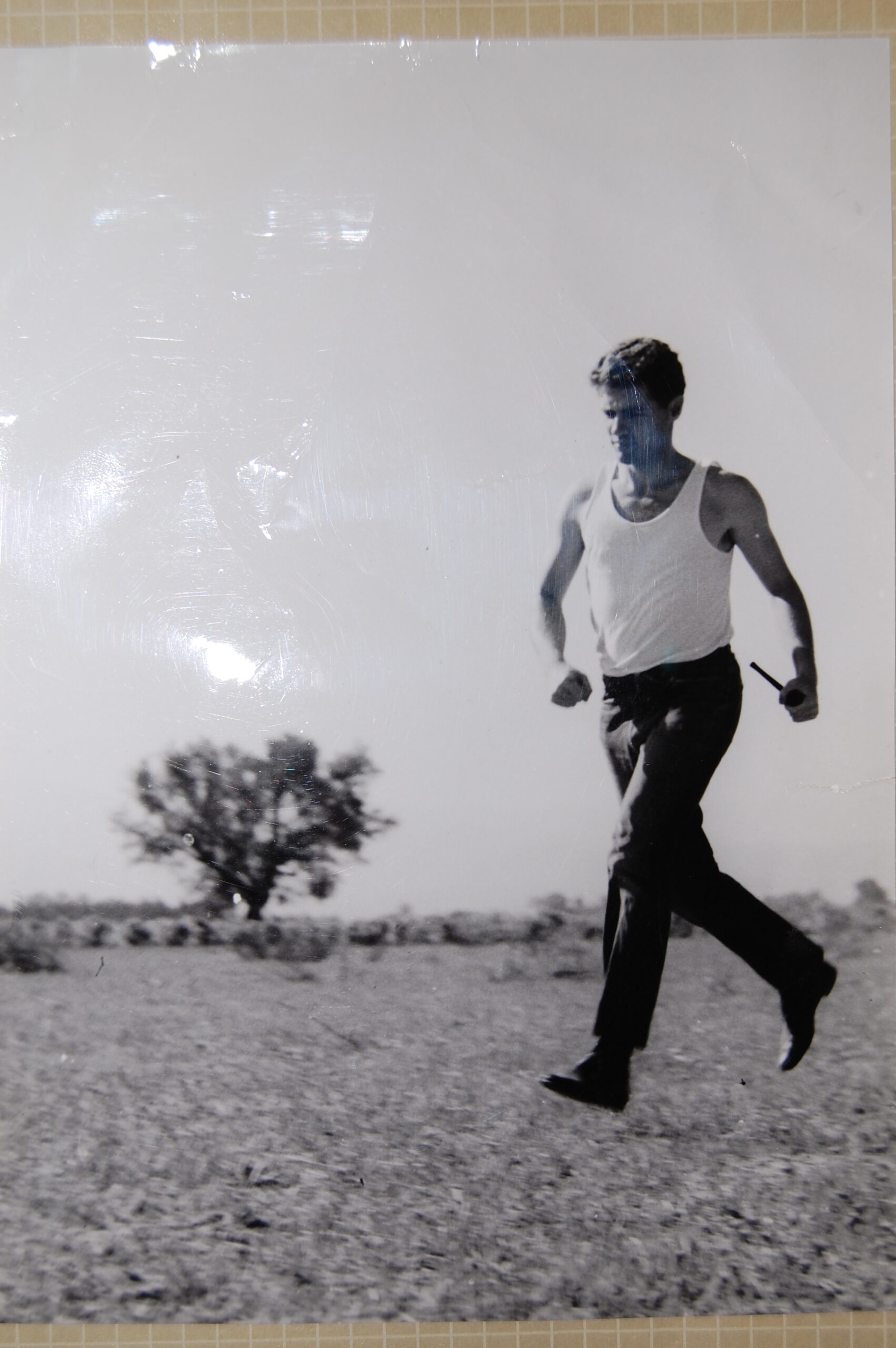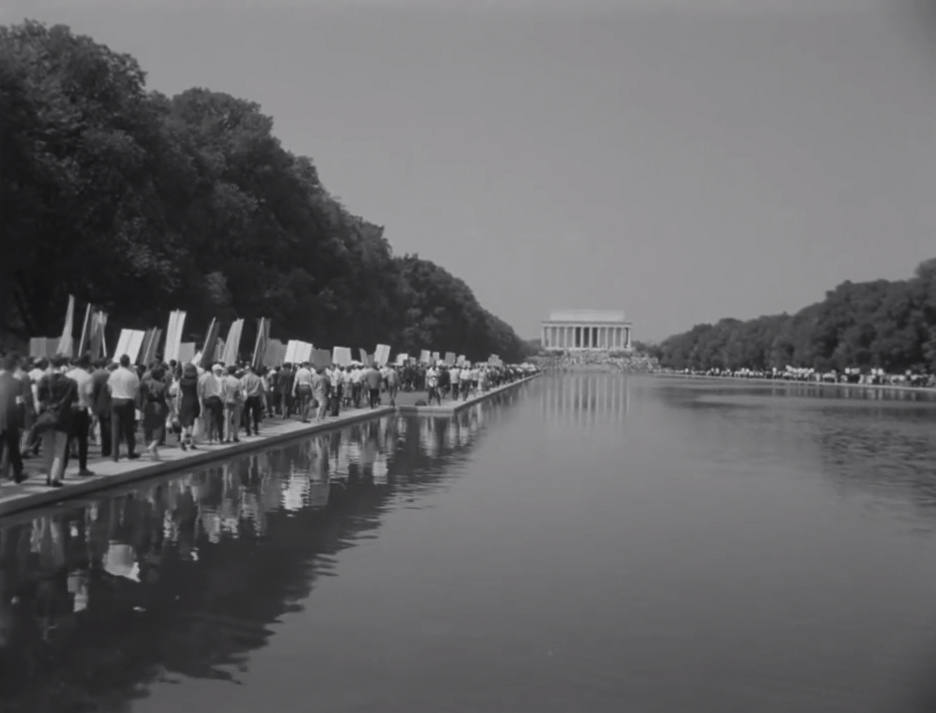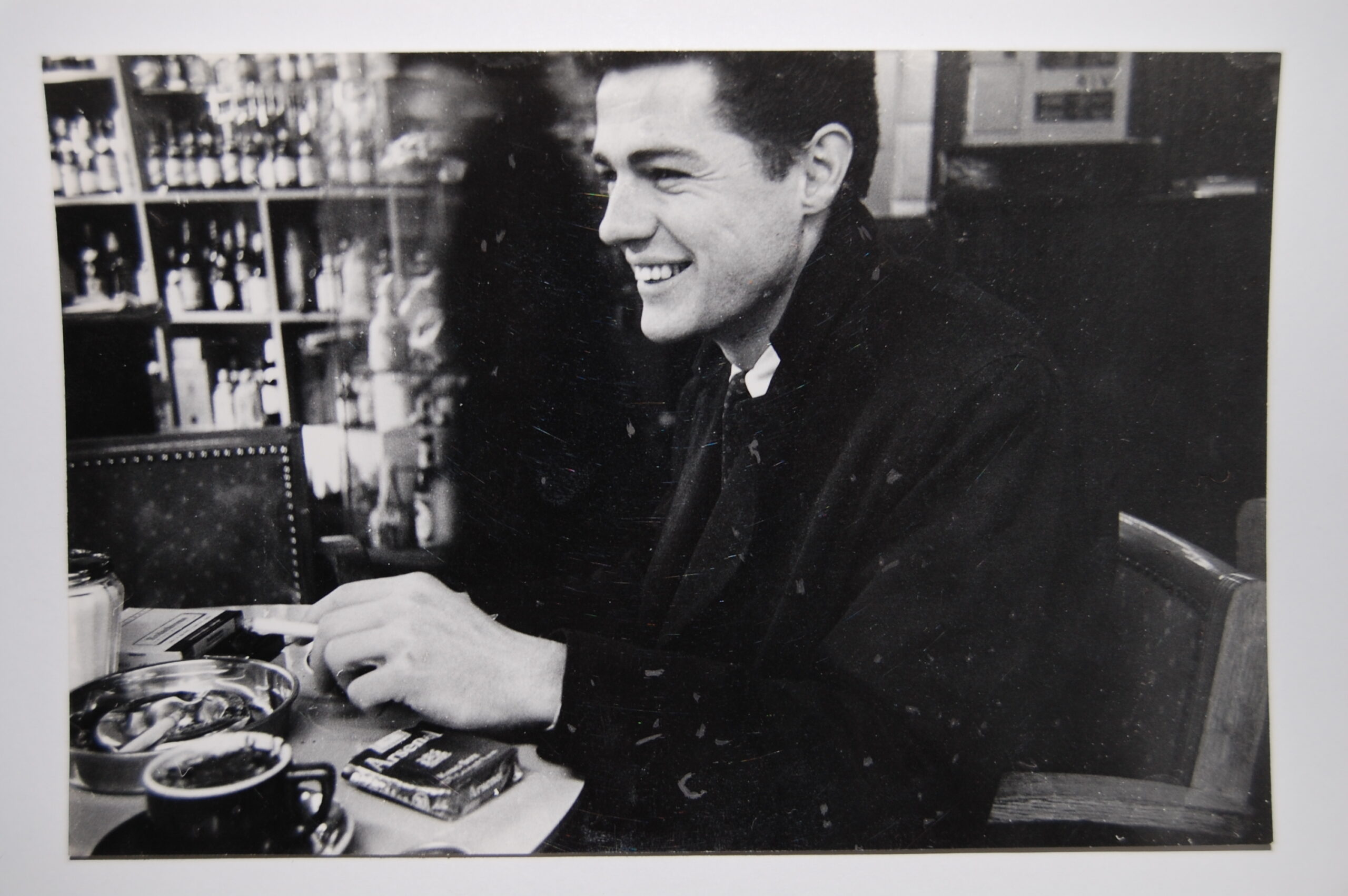
Pioneering Documentary Filmmaker
James Blue 1930-1980
“Film can be an art, yes. But it also covers a much wider domain, from social sciences to the various technologies. It is a form of symbolizing and communication which cuts across all the disciplines in life.”
James Blue, Director, The March. 1963
The James Blue Alliance (JBA) was formed as a team of scholars, filmmakers and film appreciators to undertake the preservation and promotion of James Blue’s foundational body of work and his role in the history of documentary film.
Under the leadership of his brother, Richard N. Blue, these efforts included:
- The development of an extensive archive at the University of Oregon, the restoration of James Blue’s seminal 1963 documentary The March (the source film for all retrospectives that have followed),
- The restoration and the release of Blue’s black and white feature film, shot during the Algerian war, The Olive Trees of Justice,
- The restoration and presentation of Blue’s interviews with leading film directors, (including Rossellini and Hitchcock among many others) as well as numerous events, exhibitions, seminars and biographical films.
- Currently, JBA efforts focus on the promotion and use of The March in education curricula including American history, the History of Film, the Development of Documentary Film and the Emergence of Social Media. https://blogs.uoregon.edu/themarch/ contact: [email protected]
- Blue’s urban development films The Invisible City and Who Killed Fourth Ward offer another opportunity for source educational materials, focusing on studies in areas of City Planning, Architecture and Engineering, Community Development, Social Sciences and other studies in which his films offer deep relevance.
- Combining development with international issues–agriculture, hunger, displacement and migration as well as cultural norms, values and determinism–Blue’s films are all a rich source for examination including, but not limited to, his brilliant and beautiful A Few Thoughts on Our Food Problem.
Urban Development/Housing film series https://youtu.be/F0zZ2O0qDxQ
Links to these and ongoing efforts as well as a full filmography can be found by online search for James Blue filmmaker.
James Blue died in 1980 at the age of 49. His brother, Richard Blue died in 2022 and work on his brother’s behalf continues with dedicated JBA members including Richard’s son, Daniel Blue. [email protected].
To understand James Blue, the man and his work, is a deeply gratifying journey you can begin here:
Discovering James Blue
Watch the 16 minute mini documentary Discovering James Blue
https://vimeo.com/120979936 Password is: “Discovering James Blue Film 2022” case and space sensitive)
THE JAMES BLUE ARCHIVE
Initial efforts focused on gathering Blue’s extensive archive of materials including film, film notes, teaching materials, groundbreaking documentary films, feature film, interviews with legendary film directors, as well as initiatives he led developing university media centers at Rice University as well as the University of the State of New York at Buffalo. Once gathered, the archival material was donated to the archive within the Library of the University of Oregon, James Blue’s alma mater.
https://jamesblue.uoregon.edu/
RESTORATION
In 1963 James Blue was hired by the USIS to film the then upcoming “MARCH ON WASHINGTON FOR JOBS AND FREEDOM”. His film The March remains the source historical document of this seminal event in American history. For its first restoration project, the JBA turned its attention to this film.
James Blue was also a cross cultural film maker. His award winning feature was shot during the Algerian war and included non-actors. Based on the book The Olive Trees of Justice. Watch here with a library card or University login
https://www.kanopy.com/en/product/12101597
The March versions
https://blogs.uoregon.edu/themarch/one-film-two-versions/
James Blue’s The March (1964 Restored)
James Blue Films: Links
https://m.facebook.com/rememberingdocumentaryfilmmakerjamesblue/
The March versions
https://blogs.uoregon.edu/themarch/one-film-two-versions/
Education initiative of JBA and professor David Frank, University of Oregon
https://blogs.uoregon.edu/themarch/
Making The March, the University of Oregon Prof. David Frank
https://around.uoregon.edu/content/new-project-explores-classic-civil-rights-era-uo-alum
https://around.uoregon.edu/content/new-project-explores-classic-civil-rights-era-uo-alum
Urban Development/Housing film series
https://youtu.be/F0zZ2O0qDxQ

Filmography:
Hamlet, USA, 1951-1952, 8mm film, 40 min
The Silver Spur, USA, 1956, 16mm film
Paris á I’Aube (with Johan van der Keuken), France, 1957, 35mm film, color, 10 min
Une Tragédie en Trois Mauvaises Actions, France, IDHEC, 1958, 35mm film, 5 min
Amal, Algeria, 1960, 35mm film, b/w, sound, 21 min, written and directed by: James Blue, cinematographer: Paul Fougerol, produced by: Les Studios Africa/Georges Derocles, produced for. Direction de I’Agriculture et des Forets, © Georges Derocles
Le Voleur, Algeria, 1960, 35mm film, b/w, silent, 20 min
La Princesse Muette, Algeria, 1960, 35mm film, b/w, silent, 12 min L’Avare, Algeria, 1960, 35mm film, b/w, silent, short
Le Jardin des Roses, Algeria, 1960, 35mm film, b/w, silent, 18 min L’Endormi, Algeria, 1961, 35mm film, b/w, silent, 10 min
Le Menuisier, Algeria, 1961, 35mm film, b/w, silent, 10 min Le Match-de-Catch, Algeria, 1961, 35mm film, b/w, silent, 12 min
Les Oliviers de la Justice [The Olive Trees of Justice], Algeria/France, 1962,35mm film, b/w, sound, 78 min, written by: Jean Pelegri, Sylvain Dhomme, James Blue, after a novel by: Jean Pelegri (1956, Editions Gallimard, Paris), directed by: James Blue, dialogue: Jean Pelegri, cin ematographer: Julius Rascheff with Ouakil Boubekeur, edited by. Suzanne Gaveau, Marie-Claude Bariset, music: Maurice Jarre, produced by: Les Studio Africa/Georges Derocles, © Georges Derocles
A Letter from Colombia, Colombia/USA, 1962,35mm film, b/w sound, 9:30 min, written, directed, and narrated by: James Blue, cinema tographer: Stevan Lamer, produced by: United States Information Agency (USIA)
The School at Rincon Santo, Colombia/USA, 1962,35mm film, b/w, sound, 10:40 min, written, directed and narrated by: James Blue, cinematographer: Stevan Larner, produced by: United States Information Agency (USIA)
Evil Wind Out, Colombia/USA, 1962, 35mm film, b/w, sound, 10 min, written, directed and narrated by: James Blue, cinematographer. Stevan Larner, produced by: United States Information Agency (USIA)
The March (The March on Washington, August 28, 1963), USA, 1963-1964, 35mm film, b/w, sound, 32 min, directed and narrated by: James Blue, produced by: United States Information Service (USIS)
A Few Notes on Our Food Problem, Taiwan/lndia/Kenya/Brazil/USA, 1968, 35mm film, color, sound, 35 min, written, directed and narrated by: James Blue, cinematographer and co-director: Stevan Larner, co-written by: Gill Dennis, edited by: Lee Alexander, Meyer Odze, produced by: United States Information Agency (USIA)
Karate Texas (with David MacDougall), USA, 1971-1973, Super 8 film, color, unfinished
Kenya Boran, Parts I and II (with David MacDougall), 1974,16mm film, color, sound, 66 min, directed by: James Blue, David MacDougall, cinematographer: David MacDougall, sound: James Blue, produced by: Norman Miller in cooperation with National Film School of Great Britain and the ministry of Natural Resources, Government of Kenya, with a grant from the National Science Foundation (USA)
Boran Herdsmen (with David MacDougall), 1974,16mm film, color, 20 min
Boran Women (with David MacDougall), 1974,16mm film, color, 20 min
Harambee – “Pull Together” (with David MacDougall), 1974, 16mm film, color, 20 min
Who Killed Fourth Ward? A non-fiction Mystery in Three Parts, USA,1976-1977, Super 8 film, transferred to 2 inch video for broadcast, color, sound, produced and directed by: James Blue, cinematographer: Brian Huberman, sound and edited by: Ed Hugetz, with: Tom Wright (Journalist), produced with support from: Media Center at Rice University, Houston, Southwest Alternate Media Project (SWAMP), National Endowment for the Arts, KUHT-TV, Channel 8, Houston, TX,
Part One: Witnesses, 54:30 min;
Part Two:Suspects, 61:20 min;
Part Three: The Guilty, 57 min
The Invisible City (Houston’s Housing Crisis) (with Adèle Naudé Santos), USA, 1979, Super 8 film and 3k inch video, color, sound, directed by: James Blue, Adèle Naudé Santos, video and film production: Lynn Corcoran, Tom Sims, produced with support from: Texas Committee for the Humanities, National Endowment for the Humanities, KUHT-TV, Channel 8, Houston, TX, Southwest Alternate Media Project (SWAMP), produced by: SWAMP, humanist advisors: Baruch Brody (Rice University, Houston, Chairman Dept. Philosophy), June Holly (Director, Houston Committee for the Humanities and Public Policy), Harold Hyman (Rice University, Chairman Dept. Sociology), Naomi Lede’ (TSU, Director of Research, Urban Resources Center), William Simon (University of Houston, Professor of Sociology), Maria-Luisa Urdaneta (University of Texas, San Antonio, Medical Anthropologist), Douglas Uzzell (SMU, Urban Anthropologist)
Part #1, 59:30 min
Part #2, 29 min
Part #3, 29 min
Part #4, 29 min
Part #5, 59:30 min
The Invisible City (Summary) (with Adèle Naudé Santos), USA, 1980, Super 8 film and % inch video, color, sound, 60 min, directed by: James Blue, Adèle Naudé Santos, video and film production: Lynn Corcoran, Tom Sims, produced with support from: Texas Committee for the Humanities, National Endowment for the Humanities, KUHT-TV, Channel 8, Houston, TX, Southwest Alternate Media Project (SWAMP), produced by: SWAMP, humanist advisors: Baruch Brody (Rice University, Houston, Chairman Dept. Philosophy), June Holly (Director, Houston Committee for the Humanities & Public Policy), Harold Hyman (Rice University, Chairman Dept. Sociology), Naomi Lede’ (TSU, Director of Research, Urban Resources Center), William Simon (University of Houston, Professor of Sociology), Maria-Luisa Urdaneta (University of Texas, San Antonio, Medical Anthropologist), Douglas Uzzell (SMU, Urban Anthropologist)
Unproduced scripts
King’s Mountain and Its Heroes (with Richard Blue and Gill Dennis), USA, 1970, script for a feature film
Gill Dennis, Watch for the Razor Act, USA, 1968, script based on an idea and research of James Blue

The March
The March is a documentary by filmmaker James Blue (1930-1980) about the March on Washington for Jobs and Freedom in August of 1963. Blue filmed participants as they prepared for the March on Washington in their home cities, followed them as they traveled to Washington, and recorded their reactions as they listened for the first time to Rev. Dr. Martin Luther King, Jr.’s iconic speech “I Have A Dream” on the steps of the Lincoln Memorial.
